- Home
-
Learn
- History of VI >
- Legislation & Laws >
- Vision Professionals >
-
VI Program Resources
>
- Program Printables
- Itinerant Teaching Tips
- Year at a Glance
- VI Program Handbook
- Caseload Analysis
- Organization & Time Management
- Professional Development
- Teacher Standards
- Professional Ethics
- Awards & Recognition
- APH Scholar Program
- Professional Organizations
- Certification Organizations
- Dealing with Challenges
- Professional Publications >
- Relatable Books for All Ages >
- Family Resources >
- Plan
- Basics
-
Teach
- Teaching Strategies >
-
Compensatory Skills Instruction
>
-
Social Skills
>
-
Self Determination
>
- Body Image & Acceptance
- Making Personal Goals
- My Vision Presentation
- My Self-Description
- Create a Personal Data Sheet
- Disclosure Decision
- Disability Statement
- Requesting Help
- Fighting Fears
- My Circle of Support
- Personal Responsibility
- Advocate for Safe Enviroments
- Having Picture Taken
- Coping with Change
- Aging Eyes
- Physical Characteristics
- Political Activism
- Laws Regarding Persons with Disabilities
-
Sensory Efficiency
>
-
Independent Living
>
- Orientation & Mobility Instruction >
- Recreation & Leisure >
-
Career & Vocation
>
-
Grow
- Complete Set Bonus >
-
Recorded Presentations
>
- Webinar: Tips for Being a "Physically Fit" TVI
- Webinar: The Art of Teaching the ECC
- Webinar: Virtual & F2F Strategies
- Webinar: Foundations of Teaching the ECC in the Age of Virtual Instruction
- Webinar: Itinerant Teaching Strategies
- Webinar: Using Themes to Teach the ECC
- Webinar: Conducting a FVLMA
- Webinar: Selecting the Right AT
- Webinar: Developing SMARTER Goals
- Webinar: Determining Service Intensity Using the VISSIT
- Webinar: Activities to Teach the ECC
- Webinar: Accessible Content for BLVI
- Webinar: Accommodations for VI
- Webinar: MIMO Strategies & Activities
- Webinar: SIDPID Strategies & Activities
- Webinar: Standard Course of Study Strategies & Activities
- Webinar: Job Tasks for Job, Career & Life
- Shop
- Jobs
Cerebral Visual ImpairmentsBy: Carmen Willings
teachingvisuallyimpaired.com Updated October 31, 2022 Cerebral (or Cortical) Visual Impairment (CVI) is currently the leading cause of visual impairment in children in developing countries due to advances in medical care, treatment, and newborn survival rates. CVI is a temporary or permanent visual impairment that is congenital (from birth) or acquired as a result of injury or diseases affecting the brain. For that reason, CVI can impact both children and adults. It is characterized by vision loss that cannot be fully explained by an eye exam, a history of a neurological condition that affects the brain, and is associated with unique visual and behavioral characteristics. While CVI is a brain based visual impairment, an individual may also have ocular condition(s), but they will not explain the unique visual needs of the individual. Furthermore, CVI cannot be corrected with glasses.
Christine Roman-Lantzy has done much research in the area of Cortical Visual Impairment. In her 2003 book, "Cortical Visual Impairment: An Approach to Assessment and Intervention", she identifies the cause of CVI can generally be thought of as conditions that affect the visual pathways or visual processing centers of the brain. It is a condition in which children have reduced visual acuity as a result of damage to posterior visual pathways. In most cases, the eyes of such children are structurally normal, yet they have diminished visual capacity. She indicates that the most common conditions associated with a diagnosis of CVI are asphyxia, perinatal hypoxic-ischemic encephalopathy, intraventricular hemorrhage, periventricular leukomalacia, cerebral vascular accident, central nervous system infection, structural abnormalities, and trauma. She further states that the occipital lobes of the cerebral cortex at the back of the brain are primarily concerned with vision; the visual messages from the eye traveling along the optic nerve pathway in the form of electrical signals are routed to this location.
Since the time Christine Roman-Lantzy wrote her original book in 2003, there has been much research and additional books published on this brain-based visual impairment. Cortical Visual Impairment it is now more widely referred to as Cerebral Visual Impairment as studies have shown it can be a result of injury to other parts of the brain and not just the visual cortex.
Diagnosing CVIWhen CVI is suspected, a review of medical and other records is needed. While CVI may suspected by a Teacher of Students with Visual Impairments, it cannot be diagnosed by a teacher. It must be diagnosed by a medical doctor, typically this will be an ophthalmologist, neuro-ophthalmologist, or neurologist. After the diagnosis, a Teacher of the Visually Impaired (TVI) or an Orientation & Mobility Specialist (O&M) can help the team develop an appropriate plan that includes interventions and adaptations that meet the individual student's needs. The Pediatric cortical Visual Impairment Society has information on their website specifically for medical doctors to assist in the process of diagnosing CVI.
Assessing CVIThe CVI RangeDr. Roman-Lantzy developed the CVI Range© to assess the degree of impact on visual functioning of an individual with CVI. The CVI Range© evaluates the extent to which following 10 characteristics of CVI interfere with the individual's use of vision. In general, the greater the severity of CVI, the greater the number of CVI characteristics present. However, these characteristics may change or improve.
Matt Tietjen's "What's the Complexity?" FrameworkThe What's the Complexity assessment developed by Matt Tietjen, evaluates the complexity of the learning materials and environment and what is most accessible for learning.
Dr. Gordon Dutton's Visual Skills InventoryThis visual skills inventory developed by Dr. Gordon Dutton is designed for parents. It guides parents in answering questions about the child's visual attention, visual field function, attention to light, distance attention, visually based interactions with people, perception of movement, difficulties with visual complexity difficulties with other senses, and difficulty with visually guided movement and visual recognition.
The Perkins CVI ProtocolThe Perkins School for the Blind is in the process of developing a new digital assessment system and educational roadmap for the whole child. While it is still in development, the following 16 characteristics of CVI can be found on their CVI NOW website:
StrategiesBecause the brain has the ability to change, known as neuroplasticity, and develop new connections in spite of damage, it is possible for vision to improve when the individual participates in intentional interventions.
If you discover that the individual has a history of seizures, be very cautious in using any flashing lights as this may trigger a seizure.
CVI Book Resources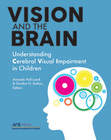
Lueck, Amanda Hall. Vision and the Brain: Understanding Cerebral Visual Impairment in Children. American Foundation for the Blind, 2015. Cerebral visual impairment, also known as cortical visual impairment, or CVI, has become the most common cause of visual impairment in children in the United States and the developed world. Vision and the Brain is a unique and comprehensive sourcebook of current knowledge about CVI and best practices for working with children. Expert contributors from many countries illuminate the complexities of vision loss related to brain injury and neurological causes and provide readers with approaches to assessment and intervention.
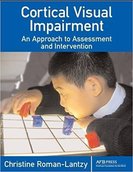
Roman-Lantz, Christine. Cortical Visual Impairment: An Approach to Assessment and Intervention. American Foundation for the Blind, 2007. This resource book includes the unique assessment tool developed by Christine Roman-Lantzy and systematic, targeted principles to help students with cortical visual impairment. Includes a framework with which to understand working with CVI and concrete strategies in working with these students.
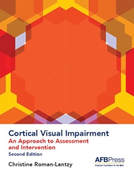
Roman-Lantz, Christine. Cortical Visual Impairment: An Approach to Assessment and Intervention, 2nd edition. American Foundation for the Blind, 2018. The new and revised content in this second edition brings the book up-to-date with new research and insights into CVI, its development and progression, and the best approaches to assessment and intervention with children affected by this condition. As in the previous edition, assessment forms, including the CVI Range and CVI Progress Chart, provide a comprehensive method for evaluating the functional vision status of, and program planning for, children with CVI.
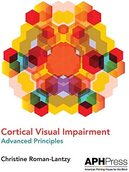
Roman-Lantz, Christine. CVI: Advanced Principles, American Foundation for the Blind, 2019. Cortical Visual Impairment: Advanced Principles, makes new strides in building knowledge about CVI. The book, a collaboration among experts in several disciplines, dives deeper into topics that are extensions of the original concepts. It identifies the needs of students and individuals with CVI in areas such as literacy, social skills, and O&M, while also addressing the demands of students with CVI and additional disabilities. The authors consider students with CVI in the context of their entire day to see how the tasks they perform, the interactions they have, and the environments they encounter can be evaluated and adapted to help them build their visual skills and experience success.
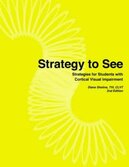
Sheline, Diane. Strategy to See. VeriNova LLC, 2016. Strategy To See is a resource book for parents/caretakers, educators and medical personnel (including but not limited to TVIs, COMS, PTs, OTs, Speech Therapists, Music Therapists, ophthalmologists, optometrists, low vision specialists and Special Education Teachers) of students from birth to 22 years who have a diagnosis of Cerebral/Cortical Visual Impairment or C/CVI. It offers specific strategies and discusses topics including brain plasticity, the importance of early intervention, the use of the CVI Skills, development of IEP Goals and Objectives and several printable handouts are provided.
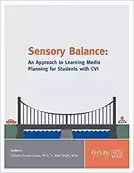
Roman-Lantzy and Tietjen. Sensory Balance: An Approach to Learning Media Planning for Students with
CVI, Perkins School for the Blind, 2020. Students with CVI have educational needs that are unique and often distinctly different from those of individuals with ocular forms of visual impairment. "Sensory Balance" refers to the combination of a person's sensory learning modalities that results in the most efficient, comfortable access to the world. The goal of the Sensory Balance Approach is to make learning media decisions that meet the child's current needs, and ensure that there are regular, intentional opportunities to develop vision into a more reliable way of learning about the world. More Online CVI ResourcesThe American Printing House for the Blind has a great CVI website with information on Cortical Visual Impairment. Information includes articles, videos, stories, as well as supports, strategies and resources.
The American Foundation for the Blind provides useful articles on Cortical/Cerebral Visual Impairment:
CVI Scotland is devoted to helping people understand cerebral visual impairments, and together work towards developing the understanding of this complex condition. They have created a free reading tool named "Look," a reading tool, with multiple functions and settings, designed to make reading easier for people with CVI.
Little Bear Sees is a website dedicated to raising awareness about cortical visual impairments. It is designed to provide the information and tools necessary for helping children with CVI learn how to see.
Perkins offers a CVI NOW website that includes information and resources specific to CVI. They also offer CVI trainings.
The Texas School for the Blind offers comprehensive resources on Cortical Visual Impairment through their SenseAbilities page.
Helpful CVI ResourcesRoman Word Bubbling Tool. This tool is an open source project designed to assist in literacy education for students with CVI. It was developed in cooperation with Dr. Christine Roman-Lantzy who originally developed the technique.
Salient Features Dictionary The Salient Features Dictionary is based on the work and ideas of Christine Roman-Lantzy, Ph.D. Dr. Roman-Lantzy defines salient features as, "the defining elements that distinguish one target from another." (Roman-Lantzy, p204). "They are," she continues, "the key pieces of distinct information that facilitate recognition of an image, object, environment, or person" (Roman-Lantzy, 2018).
|
History of Visual Impairments
Professional Practice
Vision Professionals
Professionalism
Teacher Resources
Professional Publications
VI Book Resources
Family Resources
VI Referrals
Medical vision exams
visual diagnosis
fvlma
|
|
Teaching Students with Visual Impairments LLC
All Rights Reserved |
- Home
-
Learn
- History of VI >
- Legislation & Laws >
- Vision Professionals >
-
VI Program Resources
>
- Program Printables
- Itinerant Teaching Tips
- Year at a Glance
- VI Program Handbook
- Caseload Analysis
- Organization & Time Management
- Professional Development
- Teacher Standards
- Professional Ethics
- Awards & Recognition
- APH Scholar Program
- Professional Organizations
- Certification Organizations
- Dealing with Challenges
- Professional Publications >
- Relatable Books for All Ages >
- Family Resources >
- Plan
- Basics
-
Teach
- Teaching Strategies >
-
Compensatory Skills Instruction
>
-
Social Skills
>
-
Self Determination
>
- Body Image & Acceptance
- Making Personal Goals
- My Vision Presentation
- My Self-Description
- Create a Personal Data Sheet
- Disclosure Decision
- Disability Statement
- Requesting Help
- Fighting Fears
- My Circle of Support
- Personal Responsibility
- Advocate for Safe Enviroments
- Having Picture Taken
- Coping with Change
- Aging Eyes
- Physical Characteristics
- Political Activism
- Laws Regarding Persons with Disabilities
-
Sensory Efficiency
>
-
Independent Living
>
- Orientation & Mobility Instruction >
- Recreation & Leisure >
-
Career & Vocation
>
-
Grow
- Complete Set Bonus >
-
Recorded Presentations
>
- Webinar: Tips for Being a "Physically Fit" TVI
- Webinar: The Art of Teaching the ECC
- Webinar: Virtual & F2F Strategies
- Webinar: Foundations of Teaching the ECC in the Age of Virtual Instruction
- Webinar: Itinerant Teaching Strategies
- Webinar: Using Themes to Teach the ECC
- Webinar: Conducting a FVLMA
- Webinar: Selecting the Right AT
- Webinar: Developing SMARTER Goals
- Webinar: Determining Service Intensity Using the VISSIT
- Webinar: Activities to Teach the ECC
- Webinar: Accessible Content for BLVI
- Webinar: Accommodations for VI
- Webinar: MIMO Strategies & Activities
- Webinar: SIDPID Strategies & Activities
- Webinar: Standard Course of Study Strategies & Activities
- Webinar: Job Tasks for Job, Career & Life
- Shop
- Jobs

